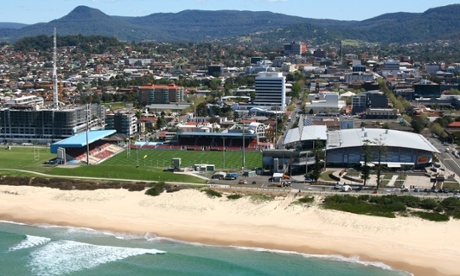The hidden underclass: how Australian underemployment is concealed
Getting
to the bottom of underemployment means spotting where casualisation has
created conditions in which employers can take advantage of workers’
desperation
to the bottom of underemployment means spotting where casualisation has
created conditions in which employers can take advantage of workers’
desperation

Wollongong, from steel city to university city.
Photograph: AAP Image
The Australian Bureau of Statistics (ABS) has recently announced a 12-year high
in the national unemployment rate. On top of this, casualisation is
growing at a blitzkrieg pace. In 2013, casual and fixed-term contracts
represented an estimated 35% of the Australian workforce, although some estimates are up around 40% today.
Proposed changes to Newstart would force job seekers under 30 to apply for 40 jobs
a month, and with this move, the government is on the verge of igniting
the employment relations tinderbox. Underemployment could be the spark.
Let’s take growing concerns over underemployment coming from the
University of Wollongong, revered by state and local political leaders
alike as a $2bn economic driver as Wollongong undergoes “economic transformation from a steel city to a university city”.
A spokesperson told me the university employs more than 2,550 full time
equivalent staff, around 18% of who are casual. The university did not
state the total number of staff actually employed. I requested the
current number of casual fixed-term contract tutors and support services
staff, but the university says it “does not report a figure for total
headcount of staff, including casual staff.” One reason casuals are
excluded in the figures, I’m told, is because it is incredibly difficult
to quantify: “some may only work a few hours in any year – that’s why
they are reported as full time equivalents”.
Used across Australian universities, the “full time equivalent”
reporting method ensures that certain facades are maintained. Sizeable
cohorts of casuals exist in an unreported black hole, a scenario highly
advantageous to the employer. Wollongong University is a vital job
supplier in the region, and yet the latest estimates, according to NTEU
branch organiser Brianna Parkins, suggest up to 60% of the university’s
teaching is done by staff on session-based casual contracts. Many of
these teachers reapply for teaching roles every four months, and have no
entitlements.
As for the national trend, it is equally staggering. According to a Melbourne University report, 67,000 academics are employed on a casual basis, comprising 60% of the Australian academic workforce.
Tackling underemployed academia is Actual Casuals,
a website run by precarious academics. The website points out that a
casual academic’s pay can be so low that they are often incapable of
earning enough to reach the minimum income tax threshold. Sessional
tutoring jobs across institutions are often filled by the same people.
This means that while accruing full time equivalent hours, sessional
tutors are unable to accumulate leave or entitlements.
The extent of underemployment in Australia has not yet been
acknowledged by minister for employment Eric Abetz, who says “when
businesses find the economic settings difficult they are less inclined
to take on new workers or to offer more hours to existing workers –
that’s why it’s so important that we get the economic fundamentals
right.” Asked about the 35% casual workforce rate, as well as the effect
it was having on communities, the minister did not respond.
ABS data shows underemployment currently stands at 7.6% of the
workforce seasonally adjusted. The Bureau defines underemployment as
workers who are seeking more hours, but there is more to it.
Oxford geography professor Craig Jeffrey, writing in The Conversation in January,
says very little has been written on this crucially important topic and
its social consequences. Jeffrey describes the phenomenon of “timepass”
– graduates waiting for jobs in an employment market too inflexible to
accommodate them. “State employment, which used to absorb many graduates
in poor countries, is no longer rising”, he says.
Social researcher Scott Burrows from Wollongong university is
concerned about the knowledge gap. He says: “Australia’s official
unemployment statistics, while providing appropriate estimates, do not
map the full extent of underemployment, of precarious work, those stuck
on fixed-term casual contracts with not enough work and with no leave
entitlements, no holiday or sick leave, no job certainty, no career
development pathways and no way out”.
Burrows says we need to map the extent of the human costs such as the
physical and mental health problems arising from underemployment, which
are concealed by the data. Not having this research can be linked to
why no one is addressing the problem, he says.
Underemployment is about more than unfairness. It is a never-ending
sense of uselessness and uncertainty about the future. Getting to the
bottom of underemployment means surveying where unemployment,
restructuring and casualisation have created conditions in which
employers can take advantage of worker desperation.
To scratch the surface, let’s look at underemployment hotspots around the country.
Launceston and the north-east of Tasmania have some of the highest
rates of youth and overall unemployment in Australia. The region’s
biggest employers are health and social assistance followed by retail,
manufacturing, education and training, accommodation and food services.
Jannette Armstrong, secretary for United Voice which represents 3,000
members working in hospitality, child care and cleaning across
Tasmania, says that there is increasing uncertainty as a result of
underemployment. “Cleaners are very worried about losing contracts. More
of the union’s members have expressed dismay at being unable to access
financing for mortgages”, she says. Cleaners are worried because, as
many contracts are short term, the system doesn’t allow cleaners to
accumulate leave. The 2012 Real Voices survey
of Australian union members reveals strong links between casualisation
and a “lack of job security, an inability to make financial commitments,
plan for the future, or live a normal life”, Armstrong adds.
Higher education is touted as a remedy for underemployment, but changes to university funding are likely to be a barrier.
The University of Queensland, which provides opportunities for
disadvantaged people to gain higher education through its college
program at the Ipswich campus, is tipped to slash staff. Ipswich is
ground zero for urban unemployment in Queensland.
The university’s agreement with the Commonwealth says programs at
Ipswich campus “are a key part of UQ’s strategy to improve access to
university among under-represented groups.” 58% of students that have
enrolled at UQ College have come from a low socio-economic status
background, and 4% are from an Aboriginal or Torres Strait Islander
background.
The university’s education union president, Andrew Bonnell, says
there are indications from management there will be some redundancies
for the campus’ 63 professional staff. Disappointed, Bonnell says “the
view of the university is now that the Ipswich campus has not met its
objectives in terms of improving access to UQ for a wider range of
students”. The university did not respond to requests for an interview.
Another remedy for underemployment has been “fly in fly out” work
(FIFO). The FIFO air bridge links precarious employment hotspots like
Ipswich to outback South Australia, which incorporates the vast expanse
of the state including mining outposts like Coober Pedy and Roxby Downs,
tops the national lists for both unemployment and youth unemployment.
But FIFO contracts are not always the obvious choice. It can be a
hard life. To improve the situation, 10 companies are now pooling
efforts with FIFO families network, a non-government organisation supporting 15,000 families across Australia and New Zealand.
Nicole Ashby from the organisation says “two weeks on two weeks off
is normal for FIFOs out on oil rigs. This can work out great for
families.” The high wages can help families escape financial hardship.
But others struggle with three weeks on, one week off schedules. “It can
be very hard when FIFOs miss milestones like their kids’ birthdays,”
Ashby says, adding that most FIFOs come from Western Australia or
Queensland. Many come from places where the effects of underemployment
and job precariousness are too much to bear.
Back in Wollongong, the FIFO population is swelling, and the recently announced 800 new retail jobs
is a landfall for the city. But will it help the underemployed? The
small print reads 800 “full time equivalent” jobs. A major potion of
these will be casual and part time gigs at retail outlets. Youth
unemployment is rampant in Wollongong. Why would anyone say no to work?
Clarice (not her real name), who landed a short-term support-services
contract at the University of Wollongong, says the attitude of her
employer is “take it or leave it”.
“The university is very good at taking advantage of the local
employment situation, you know; lots of people are willing to take
anything they can get.”


No comments:
Post a Comment